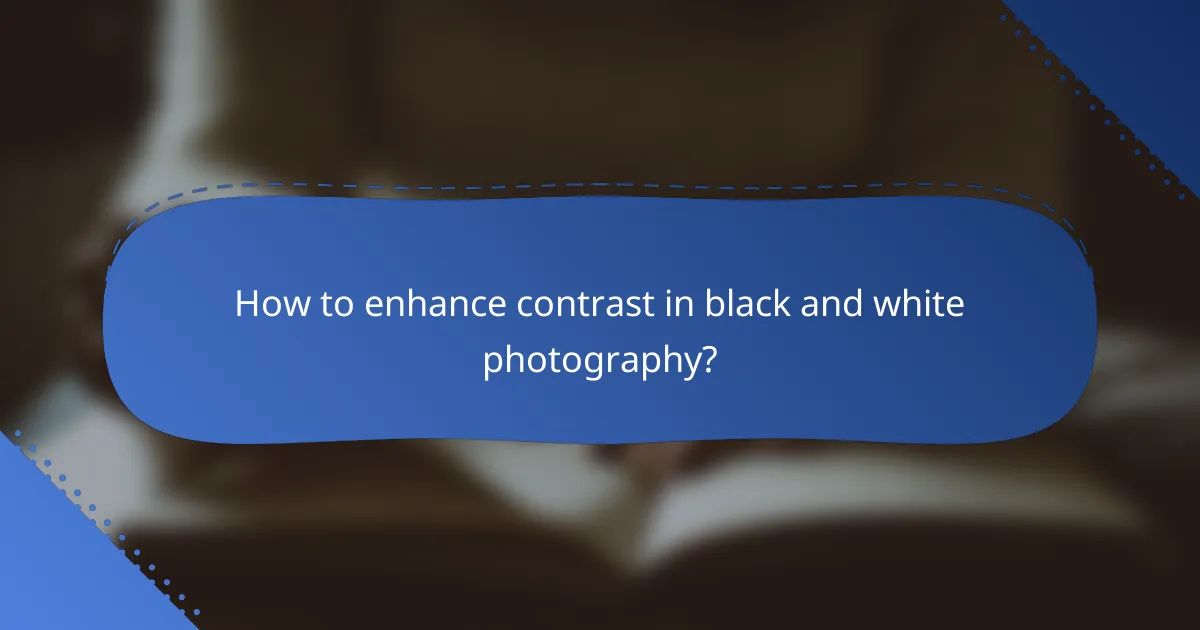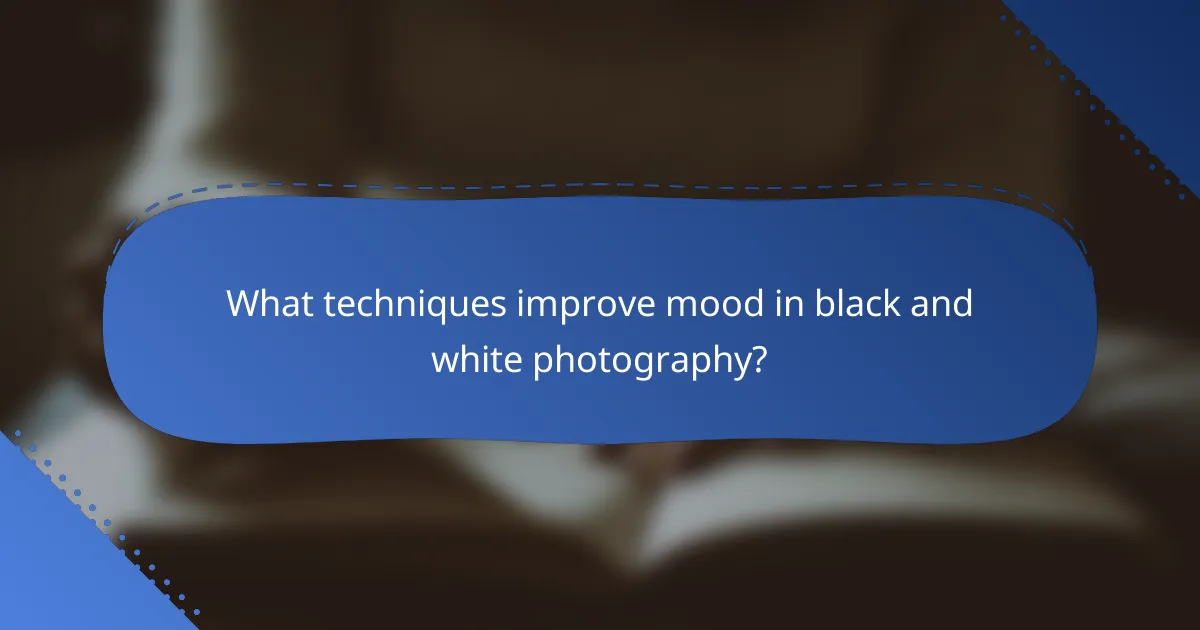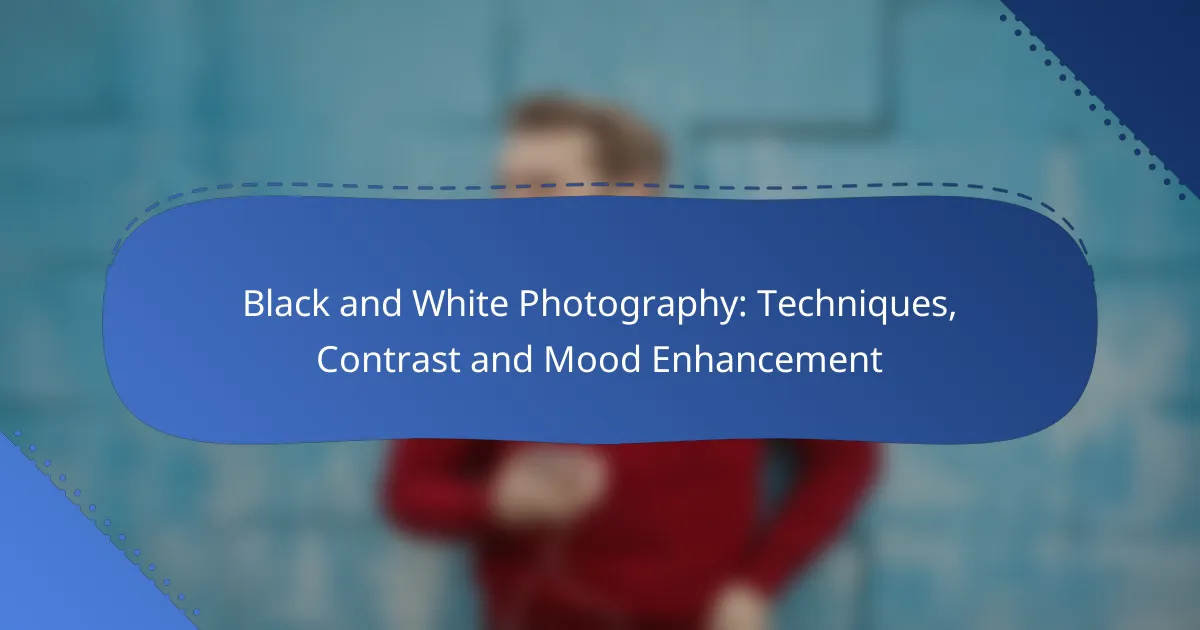Black and white photography offers a unique way to emphasize contrast and mood, transforming ordinary scenes into striking visual narratives. By manipulating tonal ranges and utilizing techniques such as filters and post-processing, photographers can evoke powerful emotions and enhance the overall impact of their images. Selecting the right camera with excellent dynamic range and tonal quality further elevates the artistry of monochrome photography.

How to enhance contrast in black and white photography?
Enhancing contrast in black and white photography involves manipulating the tonal range to create a more striking image. This can be achieved through various techniques, including the use of filters, adjusting exposure settings, and utilizing post-processing software.
Using filters for contrast
Filters can significantly impact contrast in black and white photography. A red filter, for example, darkens skies and lightens clouds, enhancing the overall contrast of the image. Similarly, yellow and green filters can adjust the tonal relationships between different elements, such as foliage and the sky.
When using filters, consider the lighting conditions and the desired mood of your photograph. Experimenting with different filters can yield varied results, so it’s beneficial to test them in various scenarios to understand their effects on contrast.
Adjusting exposure settings
Exposure settings play a crucial role in determining the contrast of a black and white photograph. Underexposing an image can deepen shadows and enhance contrast, while overexposing can flatten the tonal range. A good starting point is to slightly underexpose by one-third to two-thirds of a stop.
Be mindful of the histogram while adjusting exposure; aim for a balanced distribution of tones without clipping highlights or shadows. This practice helps maintain detail in both dark and light areas, contributing to a more dynamic contrast.
Utilizing post-processing software
Post-processing software, such as Adobe Lightroom or Photoshop, offers powerful tools for enhancing contrast in black and white images. Using the contrast slider can quickly adjust the overall contrast, while the tone curve allows for precise control over specific tonal ranges.
Additionally, consider using local adjustments like brushes or gradients to enhance contrast selectively in certain areas. This technique can draw attention to key subjects and create a more compelling composition. Always remember to keep an eye on the overall balance to avoid unnatural results.

What techniques improve mood in black and white photography?
Techniques that enhance mood in black and white photography include the effective use of contrast, shadows, and composition. By manipulating these elements, photographers can evoke emotions and create a compelling narrative within their images.
Incorporating shadows and highlights
Shadows and highlights play a crucial role in establishing mood in black and white photography. Strong contrasts between dark and light areas can create drama, while softer transitions can evoke a sense of calm. Experimenting with different lighting conditions, such as golden hour or overcast days, can yield varied emotional effects.
Consider using side lighting to accentuate textures and forms, which can add depth to your images. Additionally, backlighting can create silhouettes that emphasize the subject’s shape, enhancing the overall mood.
Choosing suitable subjects
The choice of subject significantly impacts the mood of a black and white photograph. Subjects with strong shapes, textures, or emotional expressions tend to translate well into monochrome. For instance, portraits can convey deep emotions, while landscapes can evoke feelings of solitude or grandeur.
Look for subjects that naturally lend themselves to contrast, such as weathered buildings or dramatic skies. This will help create a more striking image that resonates with viewers on an emotional level.
Employing composition techniques
Composition techniques are vital in guiding the viewer’s eye and enhancing mood in black and white photography. The rule of thirds, leading lines, and framing can all contribute to a more engaging image. For example, placing the subject off-center can create tension and interest.
Additionally, consider using negative space to emphasize your subject and evoke feelings of isolation or contemplation. Balancing elements within the frame can also help convey harmony or chaos, depending on the desired mood.

What are the best cameras for black and white photography?
The best cameras for black and white photography are those that excel in dynamic range, detail capture, and tonal quality. Models specifically designed for monochrome shooting or those with advanced image processing capabilities can significantly enhance the quality of black and white images.
Leica M10 Monochrom
The Leica M10 Monochrom is a dedicated black and white camera that captures stunning detail and rich tonal range. Its full-frame sensor is optimized for monochrome photography, eliminating the need for color filters and allowing for superior low-light performance.
With a minimalist design and intuitive controls, the M10 Monochrom is ideal for street and documentary photography. Its robust build quality and classic rangefinder style appeal to photographers who value craftsmanship and simplicity.
Fujifilm X100V
The Fujifilm X100V is a versatile compact camera that offers excellent black and white capabilities alongside its color shooting options. It features a large APS-C sensor and advanced film simulation modes, including Acros, which mimics classic black and white film.
This camera is particularly user-friendly, making it suitable for both beginners and experienced photographers. Its fixed 23mm lens provides a natural perspective, and the hybrid viewfinder allows for precise framing in various lighting conditions.
Canon EOS R5
The Canon EOS R5 is a high-performance mirrorless camera that excels in both color and black and white photography. Its full-frame sensor delivers exceptional image quality, with impressive dynamic range and detail retention, making it ideal for monochrome work.
With a wide selection of compatible lenses and advanced autofocus capabilities, the R5 is perfect for capturing a variety of subjects. Photographers can utilize its extensive editing features to enhance black and white images in post-processing, tailoring contrast and mood to their artistic vision.

How to use lighting effectively in black and white photography?
Effective lighting in black and white photography is crucial for creating depth, contrast, and mood. Understanding how to manipulate light can enhance textures and shapes, leading to striking images.
Natural light techniques
Utilizing natural light can yield stunning results in black and white photography. Position your subject to take advantage of soft, diffused light during overcast days or use direct sunlight to create strong shadows and highlights. Experiment with different times of day to see how the quality of light changes the mood of your images.
Pay attention to the direction of the light; side lighting can emphasize textures, while backlighting can create silhouettes. Always consider the time of day and weather conditions, as they significantly affect the quality of natural light.
Studio lighting setups
In a studio setting, you have complete control over lighting. Use a combination of key lights, fill lights, and backlights to sculpt your subject and create the desired contrast. Softboxes can soften harsh light, while reflectors can bounce light back onto your subject to reduce shadows.
Consider using a three-point lighting setup, which includes a key light, fill light, and backlight. This arrangement helps to create depth and dimension, making your black and white images more dynamic.
Golden hour advantages
The golden hour, occurring shortly after sunrise and before sunset, provides warm, soft light that is ideal for black and white photography. The low angle of the sun creates long shadows and highlights, enhancing textures and contrasts in your images.
During this time, the light is less harsh, allowing for more balanced exposures. This can be particularly beneficial for capturing landscapes or portraits, where the interplay of light and shadow adds emotional depth to the photograph.

What are the key elements of composition in black and white photography?
The key elements of composition in black and white photography include the effective use of contrast, balance, and visual flow. These elements help to create striking images that convey mood and emotion, enhancing the overall impact of the photograph.
Rule of thirds application
The rule of thirds is a fundamental guideline that divides the image into a 3×3 grid, placing points of interest along the lines or at their intersections. This technique creates a more balanced and engaging composition, drawing the viewer’s eye naturally across the photograph. When shooting in black and white, consider how the placement of subjects affects the interplay of light and shadow.
To apply the rule of thirds effectively, visualize your frame before taking the shot. For instance, position a prominent subject, like a tree or a building, at one of the intersections to create a dynamic focal point. This approach can enhance the depth and interest of your black and white images.
Leading lines usage
Leading lines are compositional elements that guide the viewer’s eye toward the main subject or through the image. In black and white photography, these lines can be accentuated by contrasting tones, making them more prominent. Common examples include roads, fences, or rivers that draw attention to a specific area of the frame.
When incorporating leading lines, consider their direction and how they interact with other elements in the scene. For example, a winding path can create a sense of movement, while a straight line may evoke stability. Experiment with different angles to maximize the effect of these lines in your compositions.
Framing techniques
Framing techniques involve using elements within the scene to create a “frame” around the subject, enhancing focus and depth. This can be achieved with natural elements like branches, windows, or doorways that enclose the main subject. In black and white photography, the contrast between the frame and the subject can be particularly striking.
To effectively use framing, look for opportunities in your environment. For instance, shooting through an archway can create a compelling composition that emphasizes the subject while adding context. Be mindful of how the framing elements interact with light and shadow to enhance the mood of your photograph.

How does black and white photography differ from color photography?
Black and white photography focuses on shades of gray, emphasizing light, shadow, and texture, while color photography captures a full spectrum of hues. This difference significantly influences composition, mood, and the viewer’s emotional response to the image.
Emphasis on texture and form
In black and white photography, texture and form become paramount as colors are stripped away. The absence of color forces the viewer to pay closer attention to the details of the subject, such as lines, shapes, and patterns. This heightened focus can create a more profound emotional connection to the image.
To effectively highlight texture and form, consider using side lighting or backlighting. These techniques can accentuate shadows and highlights, adding depth to the photograph. For instance, a rugged landscape or an intricate architectural detail can appear more dramatic when illuminated correctly.
When composing your shot, think about the interplay between light and shadow. Strong contrasts can enhance the three-dimensionality of the subject, making it more visually striking. Avoid flat lighting, as it can diminish the impact of textures and forms in your black and white images.
